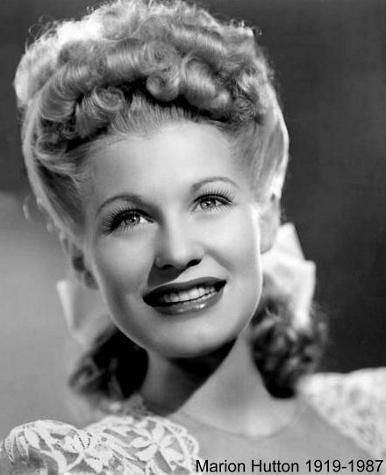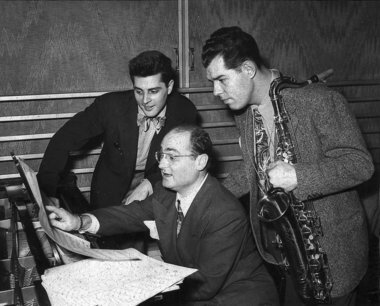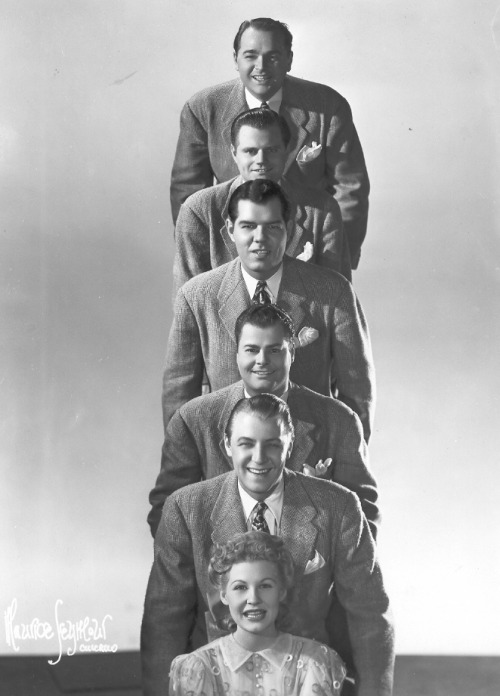
Song: Don’t Sit Under the Apple Tree / The Lamplighter’s Serenade
Artist: Glenn Miller and his Orchestra with Marion Hutton, Tex Beneke, and The Modernaires
Record Label: Bluebird Records B-11474
Recorded: February 18, 1942
Location: Service Bay lobby
You’ll hear this song just as you enter the Service Bay which specializes in maintenance and repair of luxury and passenger bathyspheres. Unfortunately, it’s become a rather popular hangout for teenagers intent on having a private place for a romantic moment, nestled in the comfy interior of half-built bathyspheres.
This song about a couple who pledge to be true to each other as the soldier marches off to war was understandably very popular during WWII. In fact, three different versions managed to become hits on the radio: Glenn Miller, The Andrews Sisters, and Kay Kyser. The Andrews Sisters memorably performed a song and dance underneath a plywood apple tree, accompanied by the Harry James Orchestra in Private Buckaroo. Unusually, Glenn Miller omits the first introductory verse.

It’s taken a long time to add a Miller song to the BioShock soundtrack with Glenn Miller’s band being the most popular of swing bands in the 30s and 40s. With perhaps only Benny Goodman’s “Sing, Sing, Sing” as a rival, Glenn Miller’s “In the Mood” would come to define the Big Band era.
Born in Iowa, Miller picked up his first trombone at the age of 12. However, during the 20s, dance band music was popular, and Miller joined as a trombone soloist for Ben Pollack and Ray Noble as well as the jazz band ensembles of Victor Young, Red Nichols, and Red McKenzie. His colleagues in the various bands would go on to become bandleaders and hot jazz musicians as well, including Benny Goodman, Tommy Dorsey, Joe Venuti, Gene Krupa, and Jack Teagarden.
Miller formed his own band in 1937, but was struggling to distinguish themselves from other bands. Then, in 1938, he experimented with a clarinet-led saxophone section which held the melody and the harmony. This unique sound would drive the band’s success with hits such as “Moonlight Serenade” (which would become the band’s signature theme), “American Patrol”, “A String of Pearls”, “Pennsylvania 6-500”, “Tuxedo Junction”, and “Chattanooga Choo Choo”, the first RCA gold record, selling over one million copies. His strict reversals and tight harmonies ensured popularity with audiences.
However, in 1942, Miller decided to join the war effort as part of the Army Air Force band. He entered the military and was able to entertain the troops to boost morale. He was scheduled to play for soldiers stationed Paris on December 15, 1944. He flew from England on a plane. It disappeared during its flight over the English Channel and Miller is still regarded as “missing in action”.

Marion Hutton was a vocalist for the Glenn Miller Orchestra during the height of its success. Older sister to esteemed actress, Betty Hutton, Marion was discovered by Miller in 1938 and often sung with his vocal group, The Modernaires. Some of her hits with the Miller Orchestra include “Yes My Darling Daughter” and “Shhh, It’s a Military Secret”. She also had a role in semi-fictional film, Orchestra Wives.

Tex Beneke with other members of the Glenn Miller Orchestra
Left to right: Johnny Desmond (singer), Jerry Gray (arranger), Tex Beneke
Tex Beneke’s smooth voice and his swinging saxophone often featured in many Miller recordings. His saxophone solo is prominent in “In the Mood” as well as his vocals in “Chattanooga Choo Choo” and “I’ve Got a Gal in Kalamazoo”.
After Miller’s disappearance in 1944, Beneke led an official “ghost band” dedicated to recreating Miller’s arrangements. As he grew tired of repeating the same orchestrations, he later formed his own band, but often rejoined with former Miller alumni and singers for occasional reunions.

The Modernaires, top to bottom: Hal Dickinson, Chuck Goldstein, Tex Beneke, Ralph Brewster, Bill Conway, Marion Hutton
Originally founded in 1935 by schoolmates, Hal Dickson, Chuck Goldstein, and Bill Conway, the Modernaires would be most famous for their association with the Glenn Miller Orchestra. Paula Kelly would join the group in 1941 as an additional vocalist. However, after Miller’s disappearance in 1944 and the band’s breakup, John Drake replaced Chuck Goldstein and Frank Scott replaced Bill Conway. The Modernaires recorded with many of the Glenn Miller arrangements with some of their hits including “Juke Box Saturday Night”, “Elmer’s Tune”, “There! I’ve Said it Again”, “That Old Black Magic”, and “Java Jive” as well as vocal renditions of Miller’s famed instrumentals.
chopinslefthand reblogged this from rapturerecords
chopinslefthand liked this
frank1915 liked this
sigmar-after-not-surviving liked this
officialpinchestacos liked this
officialpinchestacos reblogged this from havocs-archived
kingofrapture liked this
rapturerecords posted this
